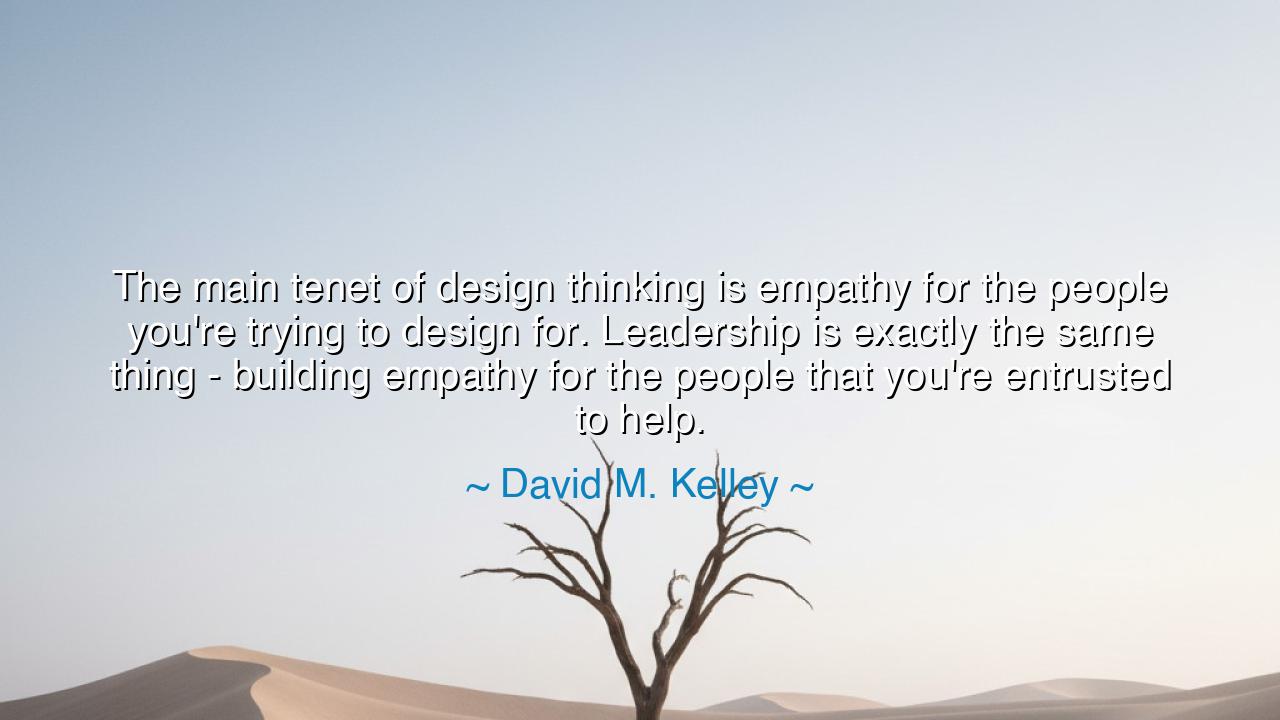
The main tenet of design thinking is empathy for the people
The main tenet of design thinking is empathy for the people you're trying to design for. Leadership is exactly the same thing - building empathy for the people that you're entrusted to help.






“The main tenet of design thinking is empathy for the people you're trying to design for. Leadership is exactly the same thing — building empathy for the people that you're entrusted to help.” — David M. Kelley
Hear, O listeners, and ponder the wisdom of David M. Kelley, the founder of IDEO and father of design thinking, who gazed upon the art of invention and saw within it the heart of compassion. In this saying, he joins two realms that the world too often separates — design and leadership. He reminds us that to design is not merely to create things, and to lead is not merely to command people; both are acts of service, grounded in empathy. Whether one builds a chair or a company, a city or a culture, the first duty of the maker is to understand those for whom the work is made.
In design thinking, the process begins not with ideas, but with observation — with seeing as others see, feeling as others feel. The designer steps into the shoes of the user, asking not “What can I make?” but “What do they need?” In this, Kelley teaches that the truest creativity is not born from pride or intellect, but from empathy — from the quiet, humble act of listening. And in this humility lies a great revelation: that the designer and the leader are kin. For leadership, too, is not the art of control, but of understanding. The leader who cannot feel what his people feel, cannot guide them; the designer who cannot imagine the user’s world, cannot create for them.
Think upon the story of Abraham Lincoln, that great architect of union. In the furnace of civil war, when his nation was divided by blood and bitterness, he did not lead from anger but from empathy. He walked among soldiers, listened to the weary and the wounded, and felt the sorrow of both the slave and the master. His strength was not only in his intellect, but in his heart — for he understood that to lead a people, one must first love them. In this, Lincoln was a true designer of human destiny, crafting not machines or monuments, but reconciliation itself.
Kelley’s words reveal that empathy is not weakness, but strength refined by wisdom. The tyrant leads through fear, the fool through pride, but the wise through understanding. Just as the sculptor studies the stone before the first strike of the chisel, so must the leader study the hearts of those he serves before he acts. For leadership, like design, is not an act of self-expression, but of translation — translating the unspoken needs of many into the actions of one. In this sacred exchange, empathy becomes the bridge between imagination and reality, between vision and service.
In the ancient world, even the builders of temples knew this truth. The architects of Athens and Thebes crafted their sanctuaries not for themselves, but for the people who prayed within them. Every column, every curve, was designed to uplift the spirit of the worshiper. They did not build to display power, but to awaken reverence. So too must the modern leader or creator work — not to display brilliance, but to serve humanity’s higher good. For every creation without empathy is hollow, and every command without compassion is tyranny in disguise.
The lesson, then, is clear: whether you are a designer, a teacher, a ruler, or a parent — practice empathy as the first principle of your craft. Listen before you act; observe before you decide. Walk among those you serve and seek to understand their joys, their fears, their struggles. Do not ask, “What will make me great?” but “What will make them whole?” For in serving others, greatness follows. The heart that feels deeply will always lead more wisely than the mind that thinks alone.
So remember, O builders of tomorrow: leadership and design are one path, and empathy is its foundation. The world will always need visionaries, but it needs, above all, listeners — those who see through others’ eyes and create with compassion. Build your work, your communities, and your lives as Kelley teaches: with empathy as your compass, beauty as your language, and service as your purpose. For only then can you call yourself not merely a designer or a leader, but a creator of humanity’s better future.






AAdministratorAdministrator
Welcome, honored guests. Please leave a comment, we will respond soon